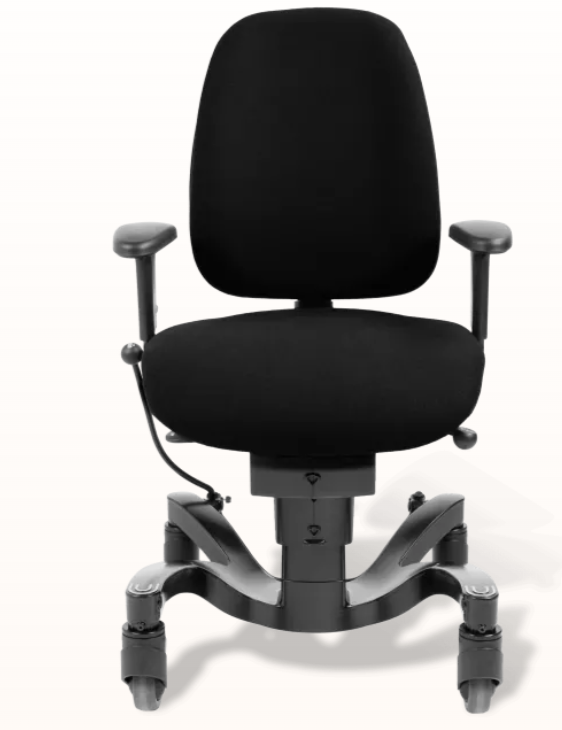Choosing The Right Chair Key Takeaways
| Factor | Consideration |
|---|---|
| Assessing Needs | Identify mobility limitations, muscle stiffness, and posture requirements. |
| Key Chair Features | Look for stability, adjustable armrests, recline functions, and pressure relief. |
| Specialist Chairs | Parkinson’s chairs offer lumbar support, stabilizing armrests, and motorized adjustments. |
| Professional Advice | Consult occupational therapists for tailored recommendations. |
| Maintenance & Upkeep | Regularly inspect for wear and adjust features as needs change. |
Enhancing Comfort and Mobility with the Right Chair
Daily activities can be challenging for disabled people, particularly when it comes to seating and mobility. The right chair can enhance independence, reduce discomfort, and improve overall well-being. Whether at home or in work environments, choosing a seating solution tailored to individual needs can transform everyday life.
This guide will help you identify key features and considerations when selecting specialist seating for Parkinson’s patients. From assessing physical requirements to evaluating chair functionality, making an informed decision ensures safety, stability, and comfort.
Assessing Individual Needs
Before exploring different seating options, it’s important to evaluate personal mobility challenges. Parkinson’s and similar conditions can impact posture, muscle control, and balance, influencing the type of chair needed.
Key Considerations:
- Postural Support: Does the user require lumbar support or a reclining function to ease back strain?
- Muscle Stiffness & Tremors: Does the chair need stabilizing features to accommodate involuntary movements?
- Ease of Transfers: Are armrests adjustable or removable to help with standing and sitting?
- Proprioceptive Needs: Does the person need a weighted chair for better grounding and support?
Occupational therapists and healthcare professionals can provide personalised recommendations based on individual needs. By understanding these requirements, you can narrow down seating options that best support comfort and functionality.
Essential Features to Look For
Once individual needs are identified, it’s time to assess specific chair features. These elements help enhance mobility, reduce fatigue, and support posture for people with Parkinson’s.
Key Chair Features
| Feature | Benefit |
|---|---|
| Adjustable Armrests | Helps with stability and support when standing or sitting. |
| Reclining/Tilt Function | Reduces pressure on joints and enhances comfort for long-term use. |
| Seat Height Adjustment | Matches the user’s lower limb length, reducing strain. |
| Firm & Stable Base | Prevents unwanted movement, improving safety. |
| Cushioned Seating | Provides pressure relief, reducing the risk of sores or stiffness. |
Choosing a chair that aligns with personal comfort preferences and mobility needs ensures better support for everyday activities.
Specialist Seating for Parkinson’s
For disabled people experiencing tremors, stiffness, or posture instability, specialist chairs for Parkinson’s patients offer targeted support. These chairs incorporate ergonomic features to accommodate movement difficulties and improve comfort.
Common Features of Parkinson’s Chairs
- Stabilising armrests to assist with safe positioning.
- Adjustable lumbar support for better spinal alignment.
- Motorised height functions for effortless standing assistance.
- Weighted or anti-tipping bases for added safety.
These seating solutions reduce strain, promote independence, and enhance overall comfort, making them an excellent choice for people with movement disorders.

Comparison Table: VELA Apex Chair, VELA Tango Chair, and VELA Independence Chair
| Feature | VELA Apex Chair | VELA Tango Chair | VELA Independence Chair |
|---|---|---|---|
| Primary Functionality | Designed for enhanced mobility and independence, particularly for Parkinson’s patients. | Focused on promoting stability and comfort during daily activities. | Multi-functional chair for mobility, safety, and independence at home or work. |
| Seat Adjustment | Electric lift function allows height adjustment at the touch of a button. | Manual height adjustment for tailored seating positions. | Electric height adjustment via buttons in the armrest for sit-to-stand assistance. |
| Braking System | Central brake system ensures stability during transfers or when stationary. | Central brake system for added safety and stability while seated. | Central brake system ensures a stable foundation for safe transfers and seated activities. |
| Mobility Features | Smooth-rolling wheels for easy maneuverability around the home. | Smooth-running wheels for effortless movement across various surfaces. | Smooth-running wheels allow walking while seated; ideal for navigating tight spaces. |
| Ergonomic Design | Foam-padded seat, backrest, and armrests provide pressure relief and proper posture. | Ergonomic padding supports posture and reduces discomfort over extended use. | Foam-padded seat, backrest, and armrests ergonomically designed for comfort and support. |
| Support for Transfers | Sturdy armrests offer additional support for sit-to-stand transitions. | Armrests designed to assist with standing and sitting transitions safely. | Electric lift function assists with sit-to-stand transitions; sturdy armrests provide support. |
| Target Users | Ideal for individuals needing advanced mobility aids with electric adjustments. | Suitable for users seeking a simpler, manual solution for enhanced comfort. | Perfect for individuals with neurological conditions like Parkinson’s or MS; supports independence. |
Maintaining and Adjusting Your Chair
A specialist chair is an investment in long-term well-being, so routine maintenance is essential. Regular checks help extend the lifespan of the chair and maintain its functionality.
Maintenance Tips:
- Inspect moving parts for wear and tear.
- Lubricate adjustment levers to ensure smooth movement.
- Check brake mechanisms (if applicable) for safety.
- Monitor cushioning and support to prevent deterioration.
As mobility needs change, reassess and adjust the chair’s features. This might include:
- Raising or lowering seat height.
- Adjusting armrests for better support.
- Replacing cushions for enhanced pressure relief.
By staying proactive with maintenance, you ensure that your chair continues to provide comfort, support, and safety for years to come.
Addressing Caregiver Needs: Tips for Assisting with Chairs, Transfers, Maintenance, and Cleaning
Caregivers play a critical role in ensuring the safety and comfort of individuals with Parkinson’s during daily activities involving seating and mobility. Here are specific tips to assist caregivers in managing chairs, performing safe transfers, and maintaining and cleaning equipment effectively:
1. Assisting with Transfers
Safe transfers are essential for both the caregiver and the patient to prevent injuries and ensure comfort.
- Chair Positioning:
- Place the chair close to the transfer surface (e.g., bed or wheelchair) at a slight angle.
- Lock any wheels or brakes on the chair to prevent movement during the transfer.
- Remove or adjust armrests if possible to allow easier access.
- Using Transfer Aids:
- Use a gait belt for added support and stability. Secure it snugly around the patient’s waist, below the ribcage.
- For patients with limited mobility, consider using a transfer board or hoist to minimize physical strain.
- Techniques for Standing Transfers:
- Encourage the patient to scoot forward in the chair until their feet are flat on the floor.
- Use verbal cues like “nose over toes” to help them lean forward before standing.
- Support them by holding the gait belt securely while bending your knees to protect your back.
- If needed, block their knees gently with yours for added stability.
- Techniques for Sitting Transfers:
- Ensure the patient’s legs touch the seat before lowering them into the chair.
- Guide them to use armrests for support while sitting down slowly.
2. Maintaining and Adjusting Chairs
Regular maintenance ensures that chairs remain safe, functional, and comfortable over time.
- Routine Inspections:
- Check for loose screws, worn-out casters, or damaged upholstery monthly.
- Test brakes, height adjustments, and reclining mechanisms to ensure they work smoothly.
- Adjustments for Comfort:
- Modify seat height or tilt-in-space features based on changes in the patient’s posture or mobility needs.
- Replace cushions periodically to maintain effective pressure relief and prevent sores.
- Lubrication:
- Apply silicone spray to moving parts (e.g., height levers or recline mechanisms) every six months to prevent stiffness.
3. Cleaning Chairs
Proper cleaning is vital for hygiene and prolonging the life of chairs used by patients with Parkinson’s.
- Daily Cleaning:
- Wipe down surfaces with a mild detergent mixed with warm water. Avoid abrasive cleaners that can damage materials.
- Use microfiber cloths to remove dirt and bacteria without scratching surfaces.
- Deep Cleaning:
- For upholstered chairs, use approved cleaning products and perform deep cleaning regularly when the patient is not seated.
- Ensure all moisture is removed from gaps between frames and upholstery after cleaning to prevent damage or mould growth.
- Waterproof Features:
- For patients with incontinence issues, ensure seat cushions are covered with waterproof fabrics. Clean these covers frequently using disinfectants safe for healthcare settings.
4. Supporting Caregiver Well-being
To avoid caregiver fatigue or injury:
- Always use proper body mechanics during transfers (bend your knees, not your back).
- Use assistive devices like hoists or sliding boards whenever possible.
- Seek guidance from occupational therapists on transfer techniques tailored to specific patient needs.
By following these tips, caregivers can create a safer environment while maintaining the functionality of chairs and ensuring patient comfort.
Useful Resourses
NHS File have produced a pdf giving information for chairs for parkinson’s patients. Download it here.
For general help and advice visit Parkinson’s UK
About the Author: Duncan Edwards
Supporting disabled family members through daily challenges has given me firsthand experience in choosing the right seating solutions for comfort and mobility. From visiting wheelchair services appointments to working with occupational therapists, I understand the importance of finding chairs that provide stability, pressure relief, and ease of transfers—particularly for conditions like Parkinson’s. Through my work with Disability Horizons Shop, I’ve helped people discover specialist aids that enhance independence. Whether it’s adjustable armrests, reclining functions, or weighted bases, I know the small details make a big difference in everyday life.


